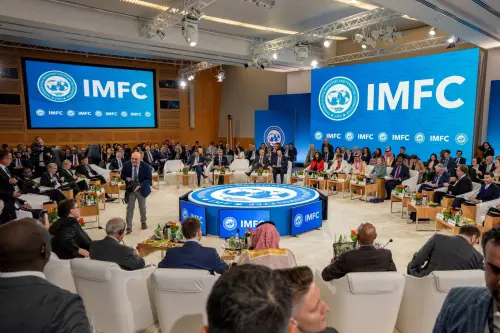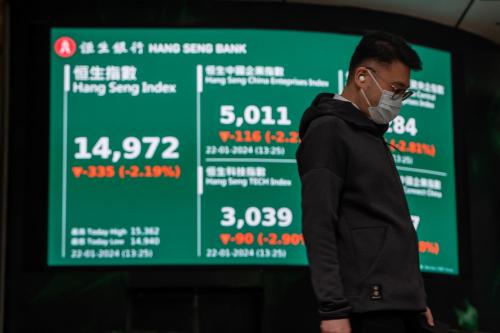Editor’s Note: As part of the Global Economic Crisis study series, Martinez- Diaz spoke at the Center for National Policy as part of a discussion focused on the impact of the global economic crisis on stability in Mexico and what that means for the United States. He outlined five crucial economic challenges facing the country that its leadership must address in order to stimulate a full and sustainable recovery.
Learn more about the series » (Also available via this link are a related video and the remainder of the transcript.)
The crisis in Mexico – Mexico went into the current crisis at a time when it was thinking hard about some of the long-term questions of its competitiveness and its economic future. Just before the collapse of Lehman and the real onset of the crisis, Mexican President Calderon was really focused on really five issues that were of extreme importance to the country, not just in the medium, but also the long term. The first was competitiveness, especially vis-à-vis China. And Mexico competes head to head with China on nine out of its ten top export products to the U.S. primarily. And there was, of course, a great concern that Mexico would be – was falling behind both in terms of its costs, not just labor but primarily infrastructure and production capacity, and second its capacity to raise capital.
The second was not competitiveness, but competition. And that is within the Mexico economy, as you may read from The New Yorker and other sources this week, the issue of monopolies and competition within the Mexican economy itself was an issue of great concern in many sectors from telecommunications to transportation.
The third big issue was tax revenue. Mexico has one of the lowest tax intakes of any Latin American country – of any emerging market country of its size, something like 12 percent of GDP and dropping as we speak. This is a problem because if you can’t collect tax revenue, it becomes quite difficult to then provide some of the public goods the government needs to provide, everything from transportation to the safety nets the ambassador was referring to.
The fourth problem was oil. The Calderon administration was very clear and tried to get a reaction out of the political system by saying very clearly and explicitly, we have 10 years left. Without any changes in investment and in exploration and production, oil will come to an end at least in terms of an important part of production and export revenues. This is a real problem because one-third of government revenues are from oil sales.
Mexico was very smart in hedging against the declines in oil prices. And so it was able to protect itself during this year setting the price at $70 per barrel even as it dropped considerably. But you cannot play this game forever. And so this was a very big concern of the government even before the crisis began.
And the last one was the issue of infrastructure and transportation. Mexico’s long-term strategic advantage is that it sits next to the largest economy in the world. But it can only work – that advantage can only really work for you as long as you have the ability to transport the goods back and forth easily and cheaply. This goes certainly to the issue of trucking which you may have heard of several times already, but it has to do a lot with the technology and the infrastructure long-term to make that happen. Something like 80 percent of trade between the U.S. and Mexico takes place through ground transportation and therefore it’s vital to have that working properly.
So those were the big questions on the president’s desk at the time the crisis hit. And so for me the real interesting question is how will these questions, and the government’s capacity to deal with them, be affected by the crisis? Because this crisis, as Larry Summers said not too many days ago, will come to an end because that’s what all crises do. The problem is what happens – in what shape are you left with after the crisis. How has the path shifted, perhaps irrevocably after that crisis has taken place?
Let me jump into the crisis a little bit and add some sort of flesh to the bones that the ambassador has laid out. As I said, I agree with his assessment. Let me show you a few numbers, not too many. This is just forecasts for the world. The problem is twofold here. One is that the big economies of Europe, Japan, and the U.S. are contracting, but we also don’t know exactly by how much so there’s great uncertainty. Obviously, the main point here for Mexico is the U.S. because of its very strong connection to the U.S. economy.
In terms of the Mexican economy itself, as the ambassador mentioned, the current expectation is that the contraction will be around 5 percent, 4 to 5 percent. It will likely be bigger than that. And if you look at this graph here – I’m not sure you can see it – it plots all of the economic paths of most of the large economies in Latin America. That bottom line is Mexico. In other words, Mexico is the hardest hit of all of the Latin American countries. And again, it’s not a coincidence it’s because of its close connection to the U.S.
Remittances, another key transmission channel. This graph shows remittances as a percent of the GDP. Mexico is right here in the middle, which means that as a percentage of GDP remittances are a relatively small part, but they’re a very important part. They’re about $22 billion a year had we measured it.
Now, to put it in context, look at all those other poor countries of Latin America, one of them in the Caribbean and Central America for whom remittances are something like a quarter, a fifth to a quarter of the GDPs. They’re going to have a very, very serious problem, and a lot of them will probably become also a concern for the United States.
This is a graph showing, as the ambassador mentioned, the decline in immigration from Mexico to the U.S. Before, one of the safety cushions for the Mexican economy and the political system really was when things get bad in Mexico, go across the border and get a job elsewhere. This worked very well for a long time because when the crisis hit Mexico, it tended to be a Mexican crisis, but not a U.S. crisis. Now we have simultaneous deceleration in economic growth on both sides of the border. And the networks of information within migrant communities are quite good, so they’re able to transmit information back to Mexico saying look, don’t come because you’re not going to get a job right now. And we’re seeing that these numbers are still behind, they’re from ’08. I think we’re going to see even steeper drops very soon.
This is the oil and gas situation I was mentioning. If you can notice on the graph on the left, the production of oil especially is beginning to decline slowly. It’s not going up at all. Gas is a slightly different story and an encouraging one. And the real problem here, of course, is the big collapse in oil prices and therefore in oil export revenues, which, as I mentioned, is not hitting the economy right now because of the hedging instrument they have used but next year that will become fully visible in the balance sheet.
One of the gloomiest of all the statistics is industrial production in Mexico. You can in many ways think of Mexico as an extension of the U.S. or North American manufacturing platform. And therefore, what we see in the United States and Canada in terms of a slowdown in consumption inevitably gets reflected in factories and workplaces in Mexico. And you can see that very clearly here. You can the collapse in manufacturing not just in services. And the fate of Detroit really is in many ways the fate of many central Mexican states because the big automakers in the U.S. have a very large number of assembly and part manufacturing plants in Mexico and therefore their futures are interlinked. Not surprisingly you see a big drop in auto manufacturing in Mexico.
Now the potentially positive side of this is that as the Big Three get their act together, as perhaps there are mergers and acquisitions involved, some of those factories in Mexico may not get shut down, but actually retooled and restructured and become part of new hopefully more successful companies. They may not be necessarily U.S. companies but they should be able to provide jobs.
The other advantage is that many of those manufacturing centers in Mexico are state of the art and many focus on the kinds of cars that we want to see built more often, very small fuel efficient cars. And, therefore, we may see an upside to this graph.
Consumer confidence is at historic lows. And that’s really the accumulation of bad news and uncertainty, not just about where the economy is going but also the flu issue and the general sense that we don’t know where things are going. As a result, people are saving. They’re postponing investment and consumption decisions. And really people just want to burry themselves underneath the ground for a while.
The informal economy, which is a huge – another big safety cushion of the Mexican economy, we don’t have good numbers on, but you can rest assured that the informal economy is absorbing large amounts of people who don’t show up in the numbers and who nonetheless are finding some livelihood and some degree of work through that system. The problem is the informal economy has limits. There’s just so many taco stands and handyman jobs that exist in the economy and after a certain point, those limits will be reached. The other problem is that those jobs generally don’t provide any kind of security in terms of health benefits or any kind of safety net.
And employment, at least formal employment, has increased. It’s now just under 5 percent. Again, this is probably understating the situation because the informal economy is not factored in.
Quick – two slides on what the government is doing. The first is, as the ambassador mentioned, a fiscal stimulus package, this time on the order of 1.5 percent of GDP, which is somewhere in the middle of sort of the reaching emerging economies. It’s – the government can afford it fairly comfortably thanks to a few years of very responsible fiscal and monetary management. The question, as in the U.S., is well, how quickly we’ll be able to see results? And what of the fiscal stimulus is going into construction, into infrastructure, things like that, which require time like before they begin to generate actual results?
And finally here you see a very large measure of monetary easing as interest rates decline – or the Central Bank lowers interest rates in order to try to get more money flowing for the economy.
So, the overall picture I’m trying to paint here is one of, first of all, great uncertainty, of considerable trepidation in light of what’s going on in the U.S. economy, but with a platform that actually was quite strong. Certainly, as compared to 1994, you see a very different scenario, much better regulated banks, much more money in the bank in terms of reserves, and generally a system that is able to withstand this kind of crash much better than it would have any time before. Now that’s not a – it’s a consolation, but it’s not a big one if you happen to be one of those who have been laid off or indeed if you happen to be managing some of these large financial institutions.
So, in conclusion I want to focus on the potential sources of constraints. The real problem for the government as it tries to resolve these issues and tries to hopefully come out of the crisis in a decent position in order to tackle the big five challenges I outlined at the beginning. The big worries right now, the reasons why probably Central Bank Governor Ortiz and the Finance Minister Carstens can’t sleep at night is related to five things. One is the potential for access to capital. There is the possibility that Mexico might need very large amounts of money very quickly as it did in ’94, except this time the need for money might come in from the private sector rather than the public sector. For that reason, the Mexican government has negotiated with the IMF the possibility of drawing on $47 billion of emergency cash. The agreement is not like the one in ’94 and ’95 in which the Mexican government was obligated to take the money from the fund. In this case, it’s a precautionary arrangement. It’s kind of a new innovation the fund has put together. In fact, Mexico is the guinea pig. It’s the first country to take on – to participate in the scheme. And if it needs the money, it’s on the table. It can withdraw it.
The problem is will it be enough?
The second line of defense is a swap arrangement with the U.S. Fed., $30 billion, it’s been open for a year now and the Mexican government has begun drawing some of that money. It’s risk free for the U.S. government, but it’s certainly a very helpful influx of cash for the Mexican government, especially as it tries to get dollars to flow into the banking system.
The second potential risk, I suppose, is the oil revenue situation. As I mentioned, the hedging will run out at the end of this year and it will blow a big hole in the fiscal deficit. And the government will have to find new sources of revenue. The same problem that existed before the crisis, except now it’s sort of on fast forward and you have to find money very quickly. The alternative, of course, is the government will have to slash – either go into deficit spending or slash spending, which is not something you want to do at this juncture. Luckily the government has some – what economists call fiscal headroom, so it can continue to spend at this rate perhaps for two to three years without getting into real trouble. The problem is you can’t do this forever. And unless the government begins to find new sources of revenue, it’s going to have a problem in terms of fiscal stimulus.
The last one I’ll mention here is politics. Some of the key measures, especially the one regarding investment in the oil sector, the issue of tax reform and the issue ofbanking regulation, all will require congress to cooperate. There’s an election coming up on which the entire house of representatives will be – 500 seats will be up for reelection. And the current economic environment never helps the incumbent, which means that the president’s party, the PAN, may lose significant amounts of seats in the house, which is a real problem if you’re trying to get some of these very sensitive legislation passed. The good news perhaps is that the PRI will get most of its – the second ranking party will get most of its seats by stealing them away from the PRD whish is the left wing party which is currently in crisis, and therefore the PAN and the PRI can sit down and hopefully negotiate some of these very difficult issues.
However, we’re not – the outlook is difficult because the PRI will not want to be overly helpful to the president. On the other hand, they need to look like they are being constructive. So that’s a big question mark will happen on July 5 with the elections.
And then finally the other question is what will then happen the day the crisis begins to subside, the day that the skies begin to clear? Unfortunately the real problem – and I return to this again because it’s so important – is that if the government isn’t able to find new sources of revenue, if it’s not able to help competitiveness increase, and if it’s not able to do something about competition within the economy, it will become very difficult to tackle some of these large questions of security, of how do you provide opportunity to millions of new entrants into the job market, and how do you, in the end, continue to consolidate the gains of what is now a peaceful, democratic, and relatively stable in many ways country? And until that happens, until those resources are available, it will become quite difficult to really see Mexico as truly a Canada like member of NAFTA.
And so it’s those connections between security and the economy that in the long run will become, I think, the biggest source of concern for both governments in Mexico and in the U.S.



Commentary
The Global Economic Crisis and Mexico: Challenges for Recovery
May 28, 2009